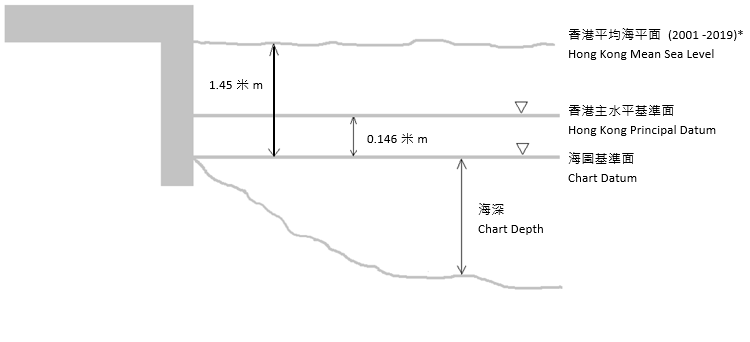|
1. Tidal characteristics in Hong Kong
Tides in Hong Kong are mixed and mainly semi-diurnal. On most of the days in a month, there are two high tides and two low tides. Large tidal range occurs twice a month during spring tides, when the moon is new or full. On days around neap tides when the moon is at its first or last quarter, however, tidal ranges become small and sometimes only one high and one low tides are observed. In general, the two high tides which occur each day are unequal in height with the higher high tide occurring mostly overnight in winter and during the day in summer.
Tides at various locations in Hong Kong display a gradual change in tidal range and in the time of occurrence of high and low tides from the southeast to the northwest across the territory. In a tidal cycle, Waglan Island is typically the first to experience the high/low tide while Tsim Bei Tsui is generally the last. The mean delay is about 1 hour and 30 minutes for high tides and around 2 hours 30 minutes for low tides. The tidal range is largest at Tsim Bei Tsui and smallest at Waglan Island. The mean tidal range is 1.4 metres at Tsim Bei Tsui and about 1 metre at Waglan Island and the Victoria Harbour.
2. Tidal predictions
Tides at all locations given in this publication are based on predictions computed by the Hong Kong Observatory using the harmonic method. In the tide tables, only the times and heights of high and low tides which occur each day are shown. For those who are interested in more detailed predictions on hourly tide levels at these locations, please contact the Hong Kong Observatory (Tel: 2926 8447). Tidal information for Hong Kong in tabular and graphic form is also available on the Internet at the Observatory's home page.
3. Units
In the tables, the time scale used is Hong Kong Time which is 8 hours ahead of Co-ordinated Universal Time (UTC). Tide height is in metre (m) above the Chart Datum which is 0.146 m below the Hong Kong Principal Datum.
4. Meteorological effect on predicted times and heights
As the predicted times and heights of the high and low tides are derived for average meteorological conditions, the observed tides may differ from those predicted when the actual meteorological conditions deviate from the mean. Under extreme conditions (e.g. during tropical cyclones), these differences might be large.
5. Explanation of terms
Semi-diurnal tide : A tidal pattern in which there are two high tides and two low tides in a day.
Tidal range : The difference in height between a high tide and the succeeding or preceding low tide.
High tide : The maximum height reached in a rising tide.
Low tide : The minimum height reached in a falling tide.
Spring tides : Semi-diurnal tides of large range occur when the moon is new or full.
Neap tides : Tides of small range occur when the moon is at its first or last quarter.
Harmonic method : The representation of tidal variations as a sum of harmonics (known as constituents) each of different frequency, amplitude and phase.
Recorded Water Level : Water level recorded by tide station, including astronomical tide and water level anomalies caused by meteorological (such as storm surge, monsoon) and non-meteorological factors (such as tsunamis).
Co-ordinated Universal Time (UTC) : The internationally adopted basis for official time. For all practical purposes, it can be taken to be the same as Greenwich Mean Time.
Chart Datum : The level to which soundings or tide heights are referenced.
Hong Kong Principal Datum (HKPD) : The level to which land surveys in Hong Kong are referenced.

|